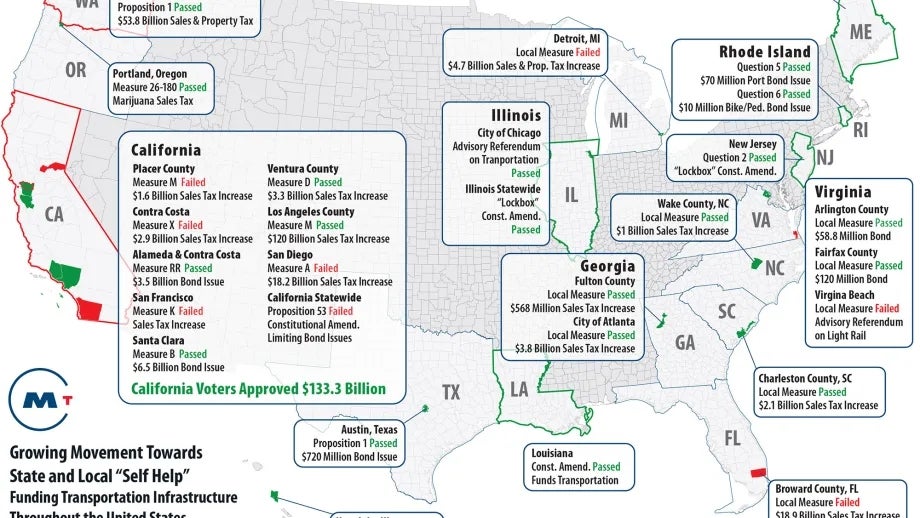Report to the Commission: November 16, 2016
Air District Open House
San Francisco, October 27
Andy Fremier and I attended the open house event hosted by the Bay Area Air Quality Management District here at Beale Street headquarters.
Bridge Yard Completion
Oakland, October 31
Andy Fremier and I again teamed up to attend a brief ceremony and business meeting to celebrate the completion of seismic retrofit work on the “Bridge Yard” building at the Bay Bridge toll plaza. This historic structure was the site of the opening ceremonies for the new east span in 2013. We are working with several public agencies and a private partner to open the facility for greater public use in association with the bicycle/pedestrian path that now reaches all the way to Yerba Buena Island.
Election Results
November 8
Local transportation (and housing) ballot measures were big winners throughout California and the nation in an historic presidential election whose results shook both political parties in Washington DC. First, the transportation news. According to the American Public Transportation Association, state and local voters approved nearly three dozen policy and funding measures for public transit and other transportation facilities, while another dozen measures failed. Notable successes included the $120 billion sales tax measure in Los Angeles; multi-billion dollar sales tax and bond measures in the Bay Area, Seattle, Charleston, and Atlanta; and statewide funding measures in Maine and Rhode Island. Unfortunately, several of the failed measures were in California, including Contra Costa County, San Diego County, and the City and County of San Francisco.
According to non-profit developer BRIDGE Housing, numerous bond and sales tax measures passed in communities throughout California to help fund affordable housing, including the following counties: Alameda, Los Angeles, San Diego, San Mateo, and Santa Clara. The map of the month found later in this report depicts the national picture of the growing local “self help” movement in funding transportation infrastructure.
In the presidential campaign, one of the few things that Secretary Hilary Clinton and businessman Donald Trump agreed about was the need to invest more in the nation’s infrastructure. Nonetheless, neither was especially forthcoming about how to pay for those improvements. President-elect Trump’s infrastructure platform features some fairly traditional GOP talking points about attracting private sector investment through tax credits and streamlining the project delivery process. Since the election, the Trump transition team has placed a price-tag of $550 billion on their infrastructure package, again with few details about how that large sum of money would be generated.
Finally, what will be the make-up of the U.S. Congress and State Legislature in the opening two years of the Trump Administration? In Washington, the Republicans comfortably retained control of the House of Representatives and narrowly retained control of the U.S. Senate. Attorney General Kamala Harris was elected to the Senate seat held by the retiring incumbent Barbara Boxer. And one major change in the Bay Area congressional delegation was the defeat of long-time Silicon Valley Representative Mike Honda by newcomer Ro Khanna. In Sacramento, it appears the Democrats achieved a 2/3 supermajority in the State Assembly, but will fall just short in the State Senate. New members and titles in the Bay Area delegation include some very familiar MTC faces, such as Senators Bill Dodd and Scott Wiener.
UC Davis Symposium
November 15-16
Dave Ory and I participated in a symposium at the University of California, Davis campus about the future of automation in public transit and passenger vehicles.
Clipper 10th Year Anniversary
November 2016
Ten years ago this month, we launched the Bay Area's transit fare payment program, then called TransLink, on AC Transit and Golden Gate Transit and Ferry. We've come a long way since 2006, including a name change to Clipper in 2010. Today, we serve riders on 20 transit agencies; last year, transit riders used Clipper to pay for nearly a quarter billion transit trips, and in that time we processed more than half a billion dollars of transit agency fare revenue. And we're not done: We are adding two final transit agencies - Union City Transit and the new SMART train - next year, while looking at the future and how to make Clipper work even better for the region. We could not have done it without the dedication of long-term staffers like Kelley Jackson and Mike Lee, the leadership of Melanie Crotty over many years of the program's inception and development, and the support of Melanie Morgan, who was instrumental in its rollout and operation and is back on Clipper staff for a return engagement.
More Housing Ideas
Last month’s report highlighted two recent policy studies from the White House and Bay Area Council on ways to build more affordable housing in metropolitan areas like our own. This month brings two more reports on the same subject from the McKinsey Global Institute and the San Francisco Business Times.
This map shows the growing movement towards state and local “self help” in the funding of transportation infrastructure throughout the United States. According to the Eno Transportation Foundation, the largest measures on the November 2016 ballot raised more than $195 billion for public transit and other transportation projects nationwide – which is equivalent to about 65% of the total funding provided by the six-year FAST Act recently approved by Congress.

